Information Systems and Big Data Analysis - Written Portfolio
VerifiedAdded on 2023/06/10
|11
|2872
|271
AI Summary
This report evaluates the theories, methods and techniques related to the design and development of information systems and big data analysis. It also discusses the impacts of IT on globalization, digital infrastructure, risks associated with information systems outsourcing and the criticality of IT infrastructure in digital transformation.
Contribute Materials
Your contribution can guide someone’s learning journey. Share your
documents today.
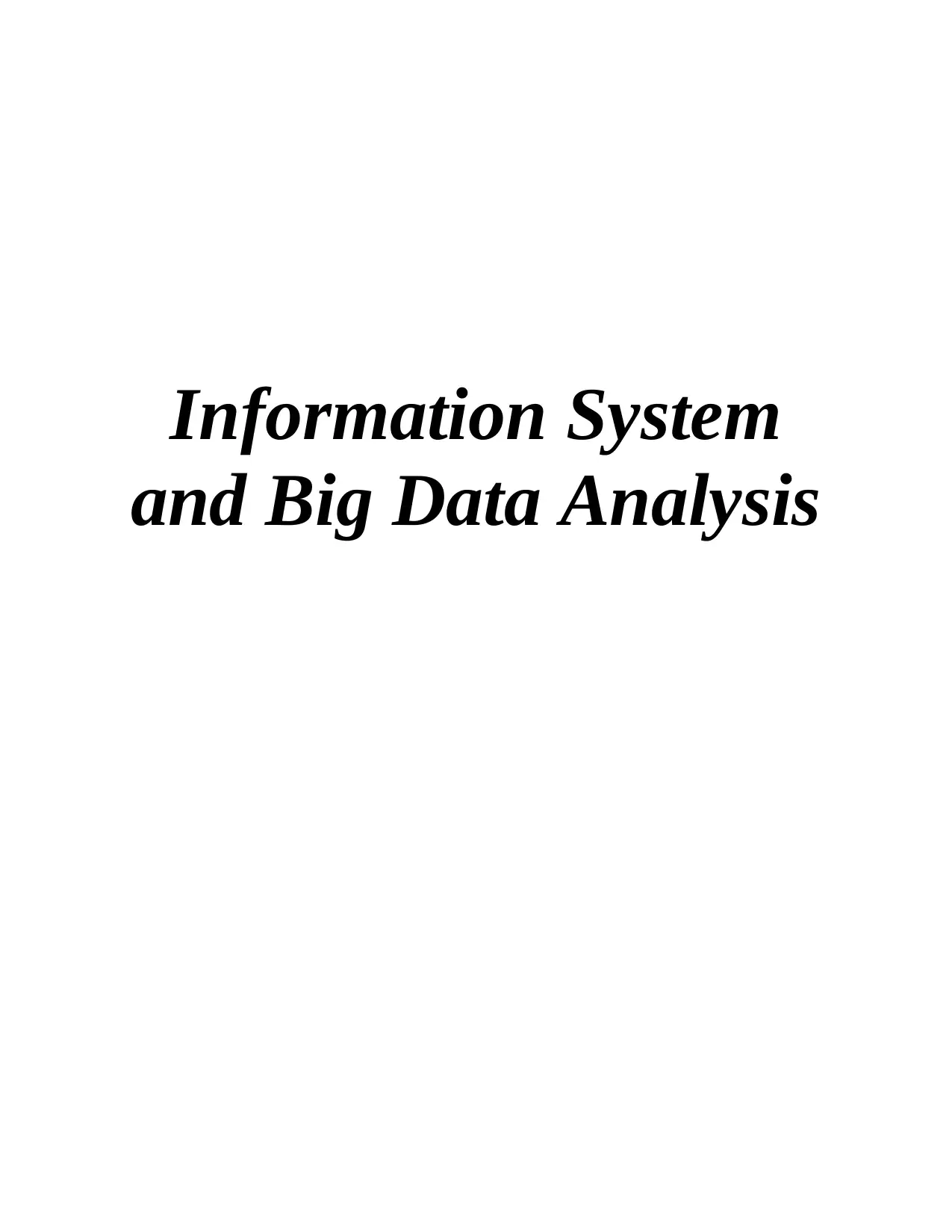
Information System
and Big Data Analysis
and Big Data Analysis
Secure Best Marks with AI Grader
Need help grading? Try our AI Grader for instant feedback on your assignments.
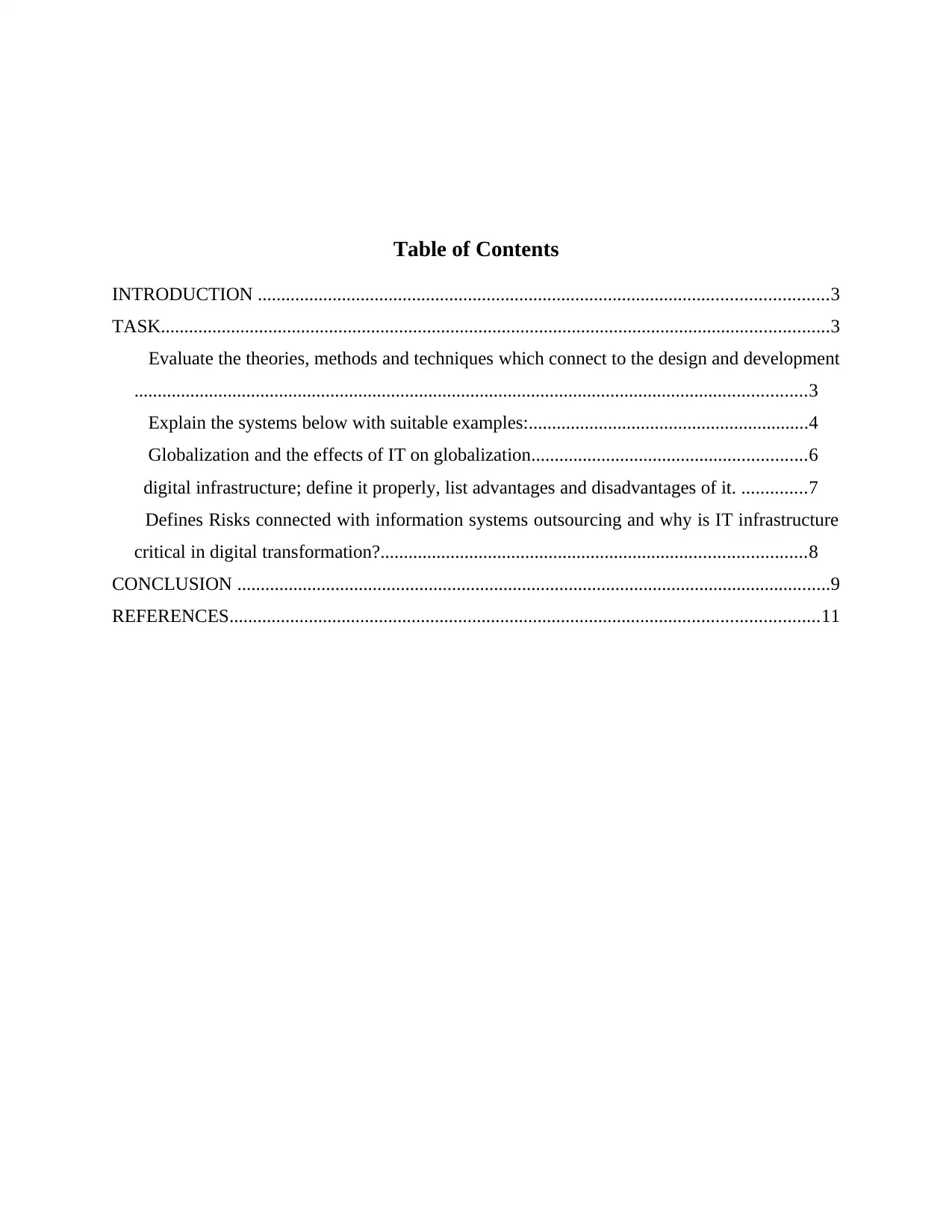
Table of Contents
INTRODUCTION ..........................................................................................................................3
TASK...............................................................................................................................................3
Evaluate the theories, methods and techniques which connect to the design and development
................................................................................................................................................3
Explain the systems below with suitable examples:............................................................4
Globalization and the effects of IT on globalization...........................................................6
digital infrastructure; define it properly, list advantages and disadvantages of it. ..............7
Defines Risks connected with information systems outsourcing and why is IT infrastructure
critical in digital transformation?...........................................................................................8
CONCLUSION ...............................................................................................................................9
REFERENCES..............................................................................................................................11
INTRODUCTION ..........................................................................................................................3
TASK...............................................................................................................................................3
Evaluate the theories, methods and techniques which connect to the design and development
................................................................................................................................................3
Explain the systems below with suitable examples:............................................................4
Globalization and the effects of IT on globalization...........................................................6
digital infrastructure; define it properly, list advantages and disadvantages of it. ..............7
Defines Risks connected with information systems outsourcing and why is IT infrastructure
critical in digital transformation?...........................................................................................8
CONCLUSION ...............................................................................................................................9
REFERENCES..............................................................................................................................11
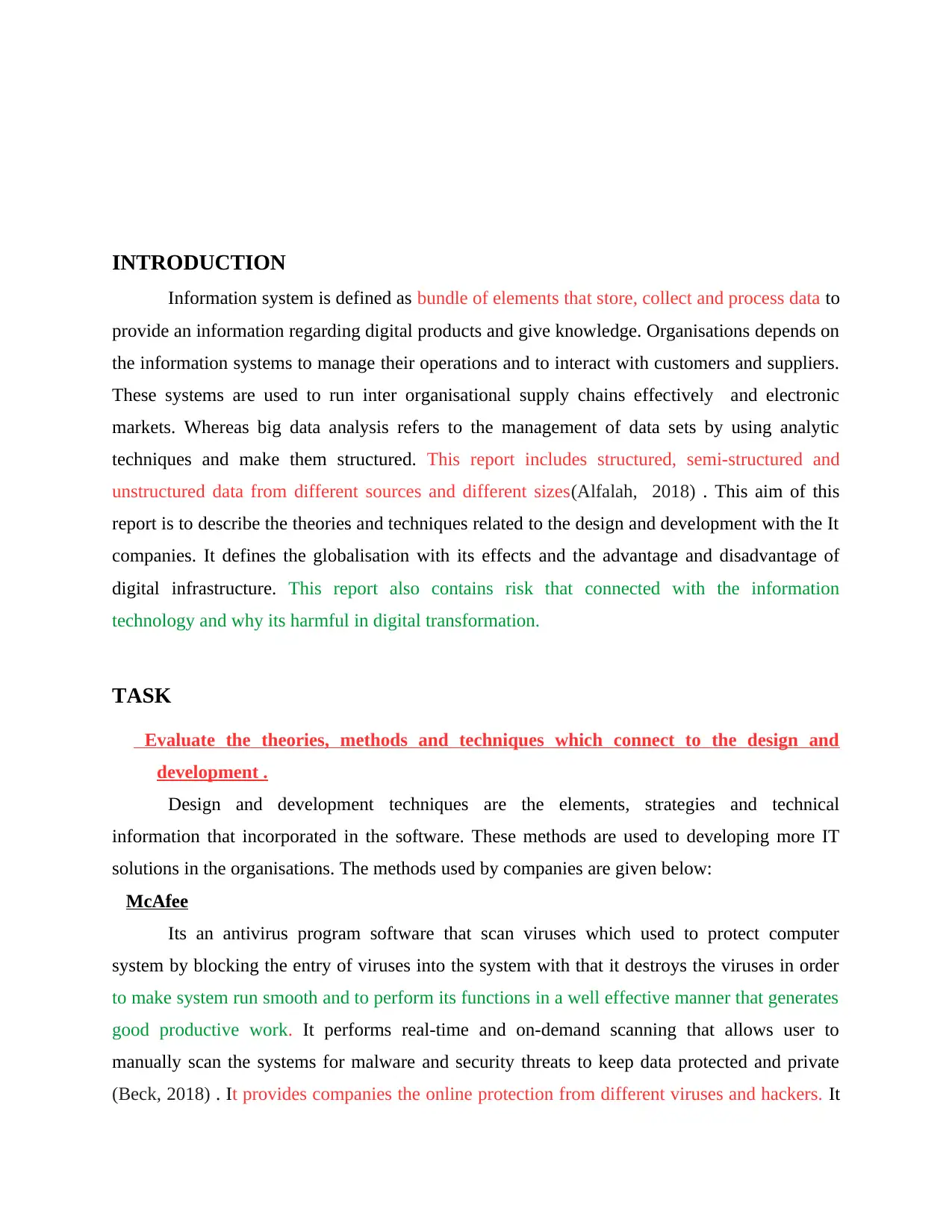
INTRODUCTION
Information system is defined as bundle of elements that store, collect and process data to
provide an information regarding digital products and give knowledge. Organisations depends on
the information systems to manage their operations and to interact with customers and suppliers.
These systems are used to run inter organisational supply chains effectively and electronic
markets. Whereas big data analysis refers to the management of data sets by using analytic
techniques and make them structured. This report includes structured, semi-structured and
unstructured data from different sources and different sizes(Alfalah, 2018) . This aim of this
report is to describe the theories and techniques related to the design and development with the It
companies. It defines the globalisation with its effects and the advantage and disadvantage of
digital infrastructure. This report also contains risk that connected with the information
technology and why its harmful in digital transformation.
TASK
Evaluate the theories, methods and techniques which connect to the design and
development .
Design and development techniques are the elements, strategies and technical
information that incorporated in the software. These methods are used to developing more IT
solutions in the organisations. The methods used by companies are given below:
McAfee
Its an antivirus program software that scan viruses which used to protect computer
system by blocking the entry of viruses into the system with that it destroys the viruses in order
to make system run smooth and to perform its functions in a well effective manner that generates
good productive work. It performs real-time and on-demand scanning that allows user to
manually scan the systems for malware and security threats to keep data protected and private
(Beck, 2018) . It provides companies the online protection from different viruses and hackers. It
Information system is defined as bundle of elements that store, collect and process data to
provide an information regarding digital products and give knowledge. Organisations depends on
the information systems to manage their operations and to interact with customers and suppliers.
These systems are used to run inter organisational supply chains effectively and electronic
markets. Whereas big data analysis refers to the management of data sets by using analytic
techniques and make them structured. This report includes structured, semi-structured and
unstructured data from different sources and different sizes(Alfalah, 2018) . This aim of this
report is to describe the theories and techniques related to the design and development with the It
companies. It defines the globalisation with its effects and the advantage and disadvantage of
digital infrastructure. This report also contains risk that connected with the information
technology and why its harmful in digital transformation.
TASK
Evaluate the theories, methods and techniques which connect to the design and
development .
Design and development techniques are the elements, strategies and technical
information that incorporated in the software. These methods are used to developing more IT
solutions in the organisations. The methods used by companies are given below:
McAfee
Its an antivirus program software that scan viruses which used to protect computer
system by blocking the entry of viruses into the system with that it destroys the viruses in order
to make system run smooth and to perform its functions in a well effective manner that generates
good productive work. It performs real-time and on-demand scanning that allows user to
manually scan the systems for malware and security threats to keep data protected and private
(Beck, 2018) . It provides companies the online protection from different viruses and hackers. It
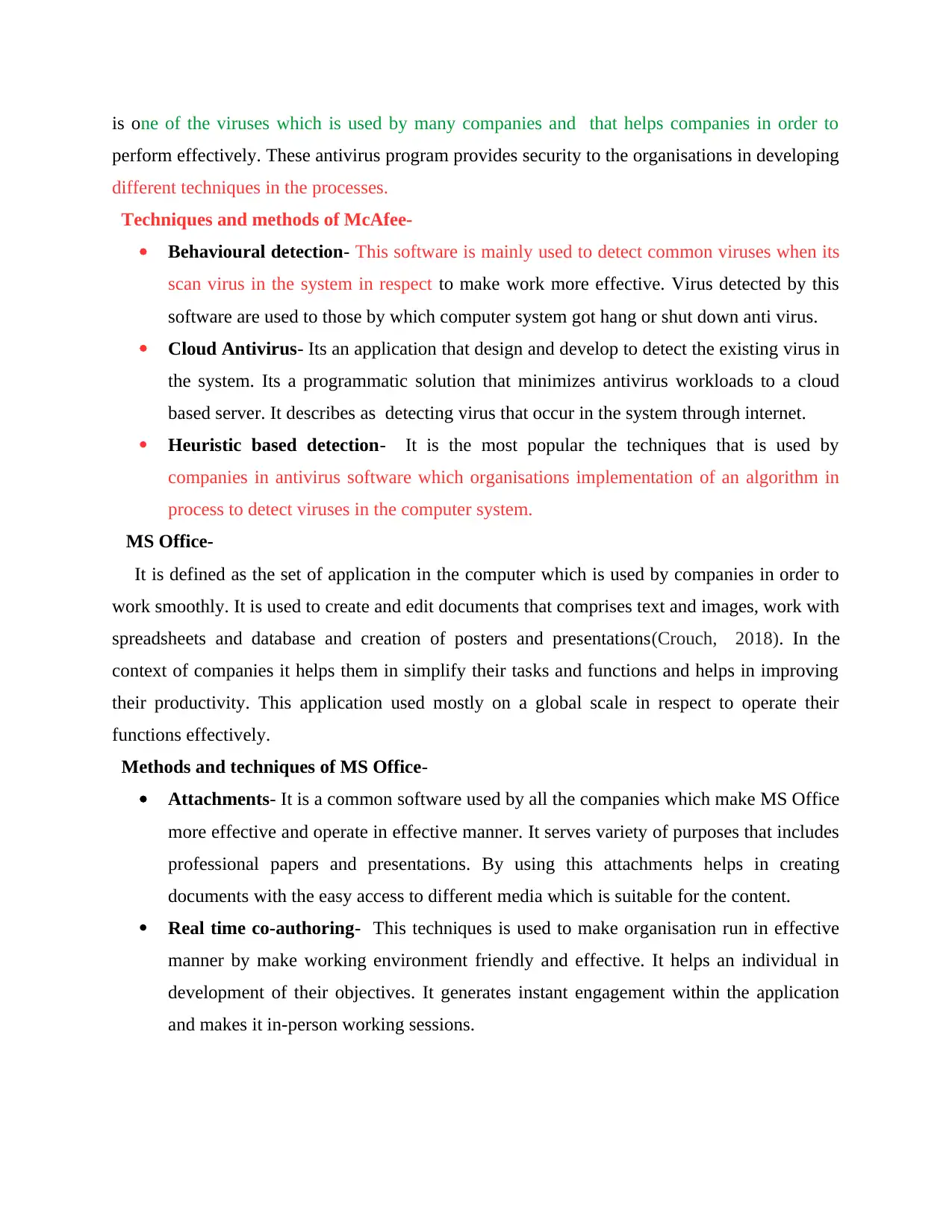
is one of the viruses which is used by many companies and that helps companies in order to
perform effectively. These antivirus program provides security to the organisations in developing
different techniques in the processes.
Techniques and methods of McAfee-
Behavioural detection- This software is mainly used to detect common viruses when its
scan virus in the system in respect to make work more effective. Virus detected by this
software are used to those by which computer system got hang or shut down anti virus.
Cloud Antivirus- Its an application that design and develop to detect the existing virus in
the system. Its a programmatic solution that minimizes antivirus workloads to a cloud
based server. It describes as detecting virus that occur in the system through internet.
Heuristic based detection- It is the most popular the techniques that is used by
companies in antivirus software which organisations implementation of an algorithm in
process to detect viruses in the computer system.
MS Office-
It is defined as the set of application in the computer which is used by companies in order to
work smoothly. It is used to create and edit documents that comprises text and images, work with
spreadsheets and database and creation of posters and presentations(Crouch, 2018). In the
context of companies it helps them in simplify their tasks and functions and helps in improving
their productivity. This application used mostly on a global scale in respect to operate their
functions effectively.
Methods and techniques of MS Office-
Attachments- It is a common software used by all the companies which make MS Office
more effective and operate in effective manner. It serves variety of purposes that includes
professional papers and presentations. By using this attachments helps in creating
documents with the easy access to different media which is suitable for the content.
Real time co-authoring- This techniques is used to make organisation run in effective
manner by make working environment friendly and effective. It helps an individual in
development of their objectives. It generates instant engagement within the application
and makes it in-person working sessions.
perform effectively. These antivirus program provides security to the organisations in developing
different techniques in the processes.
Techniques and methods of McAfee-
Behavioural detection- This software is mainly used to detect common viruses when its
scan virus in the system in respect to make work more effective. Virus detected by this
software are used to those by which computer system got hang or shut down anti virus.
Cloud Antivirus- Its an application that design and develop to detect the existing virus in
the system. Its a programmatic solution that minimizes antivirus workloads to a cloud
based server. It describes as detecting virus that occur in the system through internet.
Heuristic based detection- It is the most popular the techniques that is used by
companies in antivirus software which organisations implementation of an algorithm in
process to detect viruses in the computer system.
MS Office-
It is defined as the set of application in the computer which is used by companies in order to
work smoothly. It is used to create and edit documents that comprises text and images, work with
spreadsheets and database and creation of posters and presentations(Crouch, 2018). In the
context of companies it helps them in simplify their tasks and functions and helps in improving
their productivity. This application used mostly on a global scale in respect to operate their
functions effectively.
Methods and techniques of MS Office-
Attachments- It is a common software used by all the companies which make MS Office
more effective and operate in effective manner. It serves variety of purposes that includes
professional papers and presentations. By using this attachments helps in creating
documents with the easy access to different media which is suitable for the content.
Real time co-authoring- This techniques is used to make organisation run in effective
manner by make working environment friendly and effective. It helps an individual in
development of their objectives. It generates instant engagement within the application
and makes it in-person working sessions.
Secure Best Marks with AI Grader
Need help grading? Try our AI Grader for instant feedback on your assignments.
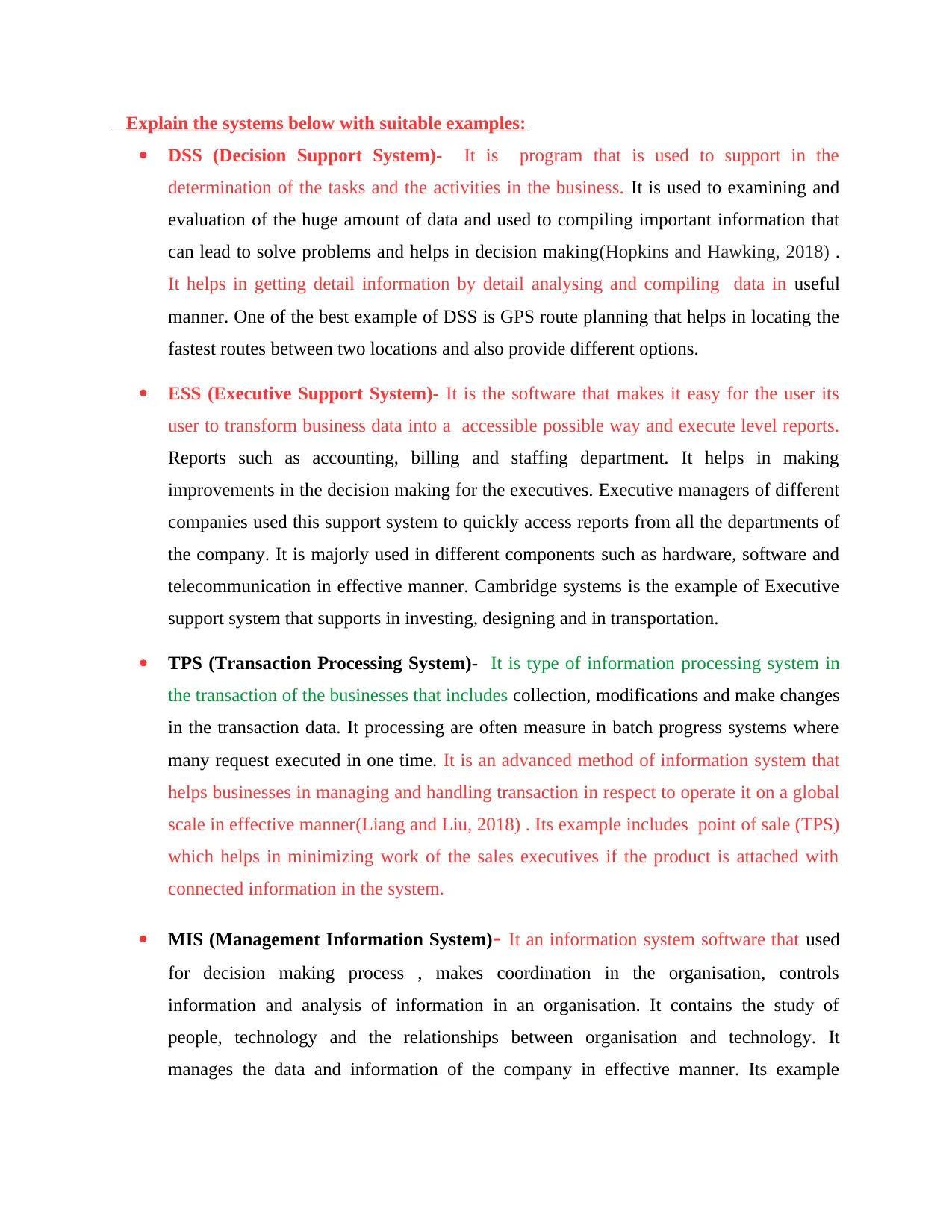
Explain the systems below with suitable examples:
DSS (Decision Support System)- It is program that is used to support in the
determination of the tasks and the activities in the business. It is used to examining and
evaluation of the huge amount of data and used to compiling important information that
can lead to solve problems and helps in decision making(Hopkins and Hawking, 2018) .
It helps in getting detail information by detail analysing and compiling data in useful
manner. One of the best example of DSS is GPS route planning that helps in locating the
fastest routes between two locations and also provide different options.
ESS (Executive Support System)- It is the software that makes it easy for the user its
user to transform business data into a accessible possible way and execute level reports.
Reports such as accounting, billing and staffing department. It helps in making
improvements in the decision making for the executives. Executive managers of different
companies used this support system to quickly access reports from all the departments of
the company. It is majorly used in different components such as hardware, software and
telecommunication in effective manner. Cambridge systems is the example of Executive
support system that supports in investing, designing and in transportation.
TPS (Transaction Processing System)- It is type of information processing system in
the transaction of the businesses that includes collection, modifications and make changes
in the transaction data. It processing are often measure in batch progress systems where
many request executed in one time. It is an advanced method of information system that
helps businesses in managing and handling transaction in respect to operate it on a global
scale in effective manner(Liang and Liu, 2018) . Its example includes point of sale (TPS)
which helps in minimizing work of the sales executives if the product is attached with
connected information in the system.
MIS (Management Information System)- It an information system software that used
for decision making process , makes coordination in the organisation, controls
information and analysis of information in an organisation. It contains the study of
people, technology and the relationships between organisation and technology. It
manages the data and information of the company in effective manner. Its example
DSS (Decision Support System)- It is program that is used to support in the
determination of the tasks and the activities in the business. It is used to examining and
evaluation of the huge amount of data and used to compiling important information that
can lead to solve problems and helps in decision making(Hopkins and Hawking, 2018) .
It helps in getting detail information by detail analysing and compiling data in useful
manner. One of the best example of DSS is GPS route planning that helps in locating the
fastest routes between two locations and also provide different options.
ESS (Executive Support System)- It is the software that makes it easy for the user its
user to transform business data into a accessible possible way and execute level reports.
Reports such as accounting, billing and staffing department. It helps in making
improvements in the decision making for the executives. Executive managers of different
companies used this support system to quickly access reports from all the departments of
the company. It is majorly used in different components such as hardware, software and
telecommunication in effective manner. Cambridge systems is the example of Executive
support system that supports in investing, designing and in transportation.
TPS (Transaction Processing System)- It is type of information processing system in
the transaction of the businesses that includes collection, modifications and make changes
in the transaction data. It processing are often measure in batch progress systems where
many request executed in one time. It is an advanced method of information system that
helps businesses in managing and handling transaction in respect to operate it on a global
scale in effective manner(Liang and Liu, 2018) . Its example includes point of sale (TPS)
which helps in minimizing work of the sales executives if the product is attached with
connected information in the system.
MIS (Management Information System)- It an information system software that used
for decision making process , makes coordination in the organisation, controls
information and analysis of information in an organisation. It contains the study of
people, technology and the relationships between organisation and technology. It
manages the data and information of the company in effective manner. Its example
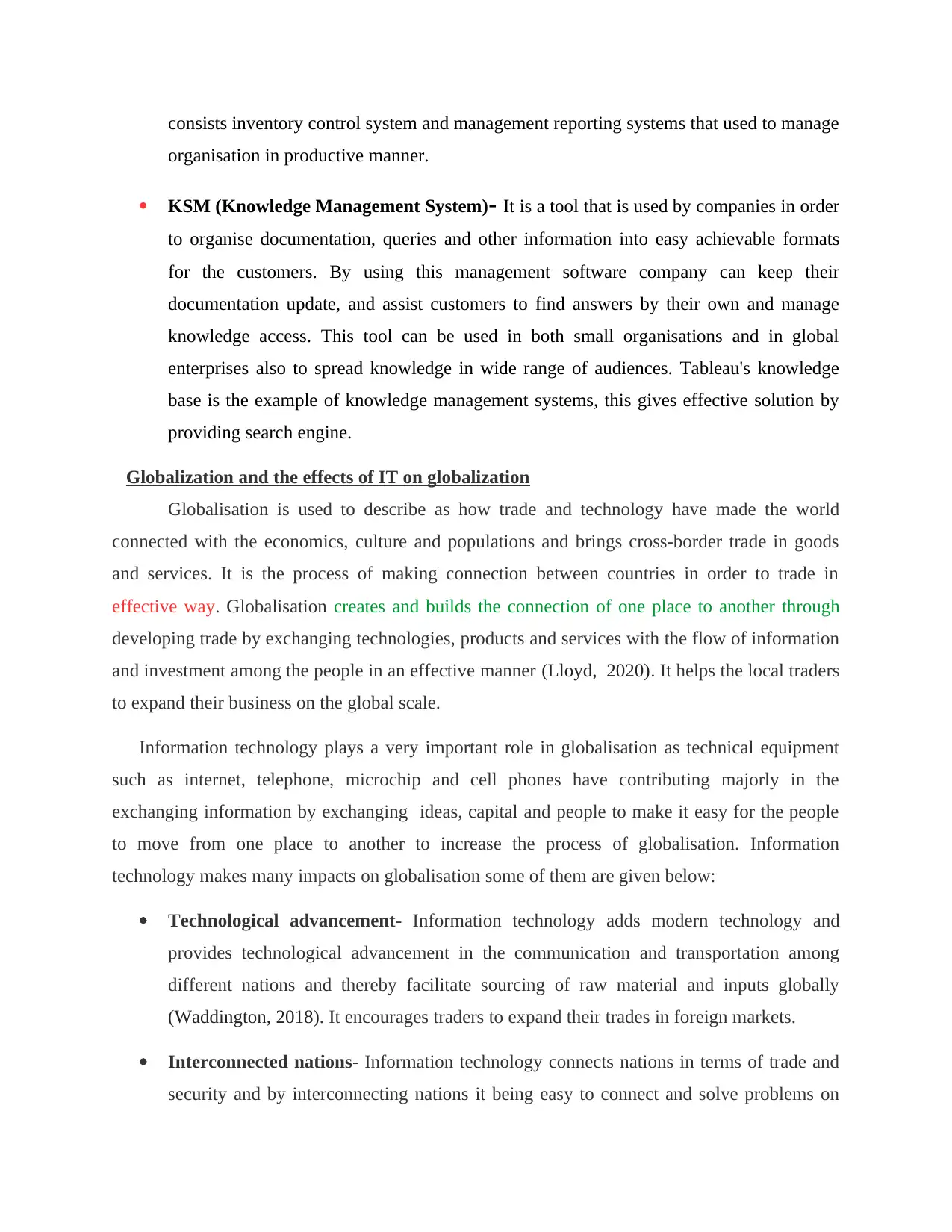
consists inventory control system and management reporting systems that used to manage
organisation in productive manner.
KSM (Knowledge Management System)- It is a tool that is used by companies in order
to organise documentation, queries and other information into easy achievable formats
for the customers. By using this management software company can keep their
documentation update, and assist customers to find answers by their own and manage
knowledge access. This tool can be used in both small organisations and in global
enterprises also to spread knowledge in wide range of audiences. Tableau's knowledge
base is the example of knowledge management systems, this gives effective solution by
providing search engine.
Globalization and the effects of IT on globalization
Globalisation is used to describe as how trade and technology have made the world
connected with the economics, culture and populations and brings cross-border trade in goods
and services. It is the process of making connection between countries in order to trade in
effective way. Globalisation creates and builds the connection of one place to another through
developing trade by exchanging technologies, products and services with the flow of information
and investment among the people in an effective manner (Lloyd, 2020). It helps the local traders
to expand their business on the global scale.
Information technology plays a very important role in globalisation as technical equipment
such as internet, telephone, microchip and cell phones have contributing majorly in the
exchanging information by exchanging ideas, capital and people to make it easy for the people
to move from one place to another to increase the process of globalisation. Information
technology makes many impacts on globalisation some of them are given below:
Technological advancement- Information technology adds modern technology and
provides technological advancement in the communication and transportation among
different nations and thereby facilitate sourcing of raw material and inputs globally
(Waddington, 2018). It encourages traders to expand their trades in foreign markets.
Interconnected nations- Information technology connects nations in terms of trade and
security and by interconnecting nations it being easy to connect and solve problems on
organisation in productive manner.
KSM (Knowledge Management System)- It is a tool that is used by companies in order
to organise documentation, queries and other information into easy achievable formats
for the customers. By using this management software company can keep their
documentation update, and assist customers to find answers by their own and manage
knowledge access. This tool can be used in both small organisations and in global
enterprises also to spread knowledge in wide range of audiences. Tableau's knowledge
base is the example of knowledge management systems, this gives effective solution by
providing search engine.
Globalization and the effects of IT on globalization
Globalisation is used to describe as how trade and technology have made the world
connected with the economics, culture and populations and brings cross-border trade in goods
and services. It is the process of making connection between countries in order to trade in
effective way. Globalisation creates and builds the connection of one place to another through
developing trade by exchanging technologies, products and services with the flow of information
and investment among the people in an effective manner (Lloyd, 2020). It helps the local traders
to expand their business on the global scale.
Information technology plays a very important role in globalisation as technical equipment
such as internet, telephone, microchip and cell phones have contributing majorly in the
exchanging information by exchanging ideas, capital and people to make it easy for the people
to move from one place to another to increase the process of globalisation. Information
technology makes many impacts on globalisation some of them are given below:
Technological advancement- Information technology adds modern technology and
provides technological advancement in the communication and transportation among
different nations and thereby facilitate sourcing of raw material and inputs globally
(Waddington, 2018). It encourages traders to expand their trades in foreign markets.
Interconnected nations- Information technology connects nations in terms of trade and
security and by interconnecting nations it being easy to connect and solve problems on
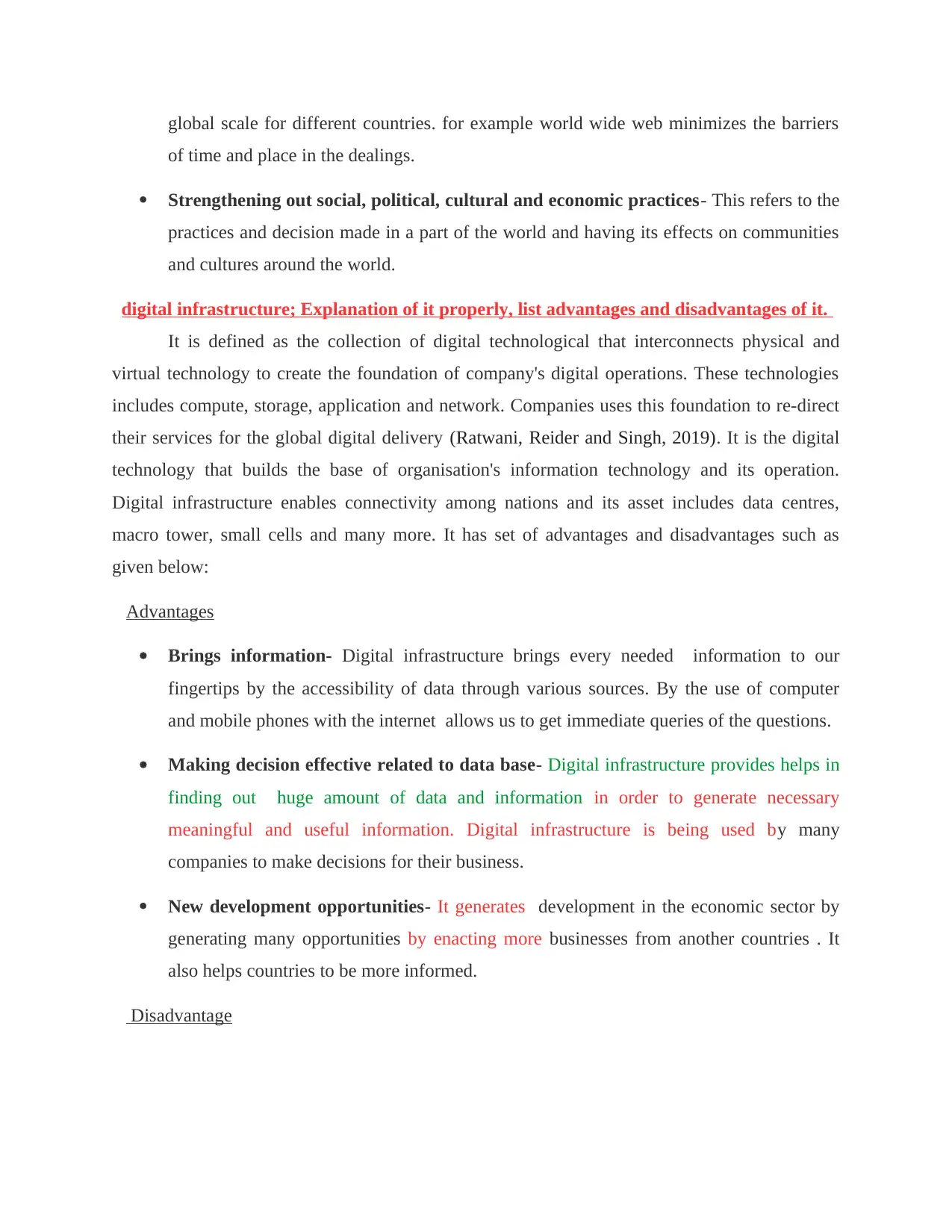
global scale for different countries. for example world wide web minimizes the barriers
of time and place in the dealings.
Strengthening out social, political, cultural and economic practices- This refers to the
practices and decision made in a part of the world and having its effects on communities
and cultures around the world.
digital infrastructure; Explanation of it properly, list advantages and disadvantages of it.
It is defined as the collection of digital technological that interconnects physical and
virtual technology to create the foundation of company's digital operations. These technologies
includes compute, storage, application and network. Companies uses this foundation to re-direct
their services for the global digital delivery (Ratwani, Reider and Singh, 2019). It is the digital
technology that builds the base of organisation's information technology and its operation.
Digital infrastructure enables connectivity among nations and its asset includes data centres,
macro tower, small cells and many more. It has set of advantages and disadvantages such as
given below:
Advantages
Brings information- Digital infrastructure brings every needed information to our
fingertips by the accessibility of data through various sources. By the use of computer
and mobile phones with the internet allows us to get immediate queries of the questions.
Making decision effective related to data base- Digital infrastructure provides helps in
finding out huge amount of data and information in order to generate necessary
meaningful and useful information. Digital infrastructure is being used by many
companies to make decisions for their business.
New development opportunities- It generates development in the economic sector by
generating many opportunities by enacting more businesses from another countries . It
also helps countries to be more informed.
Disadvantage
of time and place in the dealings.
Strengthening out social, political, cultural and economic practices- This refers to the
practices and decision made in a part of the world and having its effects on communities
and cultures around the world.
digital infrastructure; Explanation of it properly, list advantages and disadvantages of it.
It is defined as the collection of digital technological that interconnects physical and
virtual technology to create the foundation of company's digital operations. These technologies
includes compute, storage, application and network. Companies uses this foundation to re-direct
their services for the global digital delivery (Ratwani, Reider and Singh, 2019). It is the digital
technology that builds the base of organisation's information technology and its operation.
Digital infrastructure enables connectivity among nations and its asset includes data centres,
macro tower, small cells and many more. It has set of advantages and disadvantages such as
given below:
Advantages
Brings information- Digital infrastructure brings every needed information to our
fingertips by the accessibility of data through various sources. By the use of computer
and mobile phones with the internet allows us to get immediate queries of the questions.
Making decision effective related to data base- Digital infrastructure provides helps in
finding out huge amount of data and information in order to generate necessary
meaningful and useful information. Digital infrastructure is being used by many
companies to make decisions for their business.
New development opportunities- It generates development in the economic sector by
generating many opportunities by enacting more businesses from another countries . It
also helps countries to be more informed.
Disadvantage
Paraphrase This Document
Need a fresh take? Get an instant paraphrase of this document with our AI Paraphraser
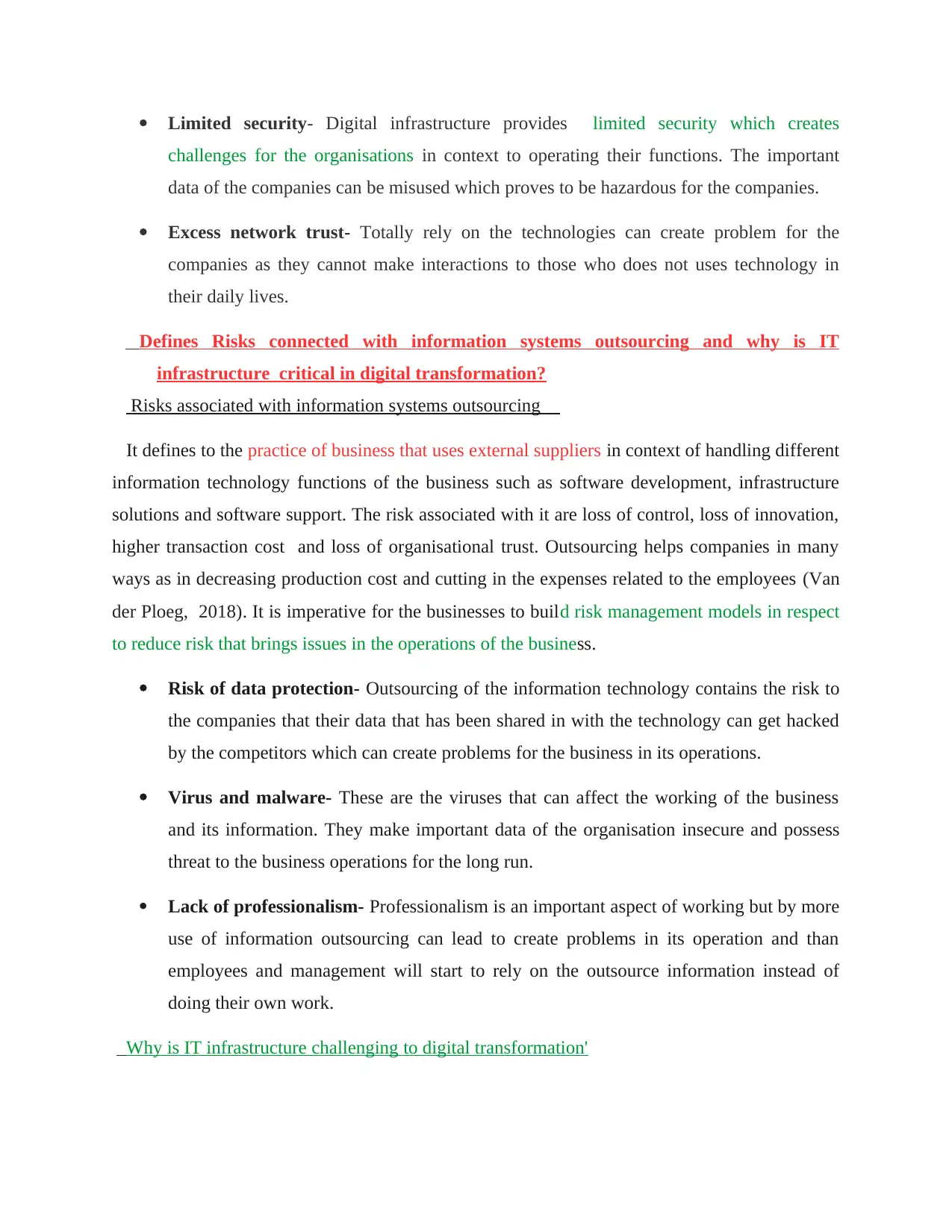
Limited security- Digital infrastructure provides limited security which creates
challenges for the organisations in context to operating their functions. The important
data of the companies can be misused which proves to be hazardous for the companies.
Excess network trust- Totally rely on the technologies can create problem for the
companies as they cannot make interactions to those who does not uses technology in
their daily lives.
Defines Risks connected with information systems outsourcing and why is IT
infrastructure critical in digital transformation?
Risks associated with information systems outsourcing
It defines to the practice of business that uses external suppliers in context of handling different
information technology functions of the business such as software development, infrastructure
solutions and software support. The risk associated with it are loss of control, loss of innovation,
higher transaction cost and loss of organisational trust. Outsourcing helps companies in many
ways as in decreasing production cost and cutting in the expenses related to the employees (Van
der Ploeg, 2018). It is imperative for the businesses to build risk management models in respect
to reduce risk that brings issues in the operations of the business.
Risk of data protection- Outsourcing of the information technology contains the risk to
the companies that their data that has been shared in with the technology can get hacked
by the competitors which can create problems for the business in its operations.
Virus and malware- These are the viruses that can affect the working of the business
and its information. They make important data of the organisation insecure and possess
threat to the business operations for the long run.
Lack of professionalism- Professionalism is an important aspect of working but by more
use of information outsourcing can lead to create problems in its operation and than
employees and management will start to rely on the outsource information instead of
doing their own work.
Why is IT infrastructure challenging to digital transformation'
challenges for the organisations in context to operating their functions. The important
data of the companies can be misused which proves to be hazardous for the companies.
Excess network trust- Totally rely on the technologies can create problem for the
companies as they cannot make interactions to those who does not uses technology in
their daily lives.
Defines Risks connected with information systems outsourcing and why is IT
infrastructure critical in digital transformation?
Risks associated with information systems outsourcing
It defines to the practice of business that uses external suppliers in context of handling different
information technology functions of the business such as software development, infrastructure
solutions and software support. The risk associated with it are loss of control, loss of innovation,
higher transaction cost and loss of organisational trust. Outsourcing helps companies in many
ways as in decreasing production cost and cutting in the expenses related to the employees (Van
der Ploeg, 2018). It is imperative for the businesses to build risk management models in respect
to reduce risk that brings issues in the operations of the business.
Risk of data protection- Outsourcing of the information technology contains the risk to
the companies that their data that has been shared in with the technology can get hacked
by the competitors which can create problems for the business in its operations.
Virus and malware- These are the viruses that can affect the working of the business
and its information. They make important data of the organisation insecure and possess
threat to the business operations for the long run.
Lack of professionalism- Professionalism is an important aspect of working but by more
use of information outsourcing can lead to create problems in its operation and than
employees and management will start to rely on the outsource information instead of
doing their own work.
Why is IT infrastructure challenging to digital transformation'
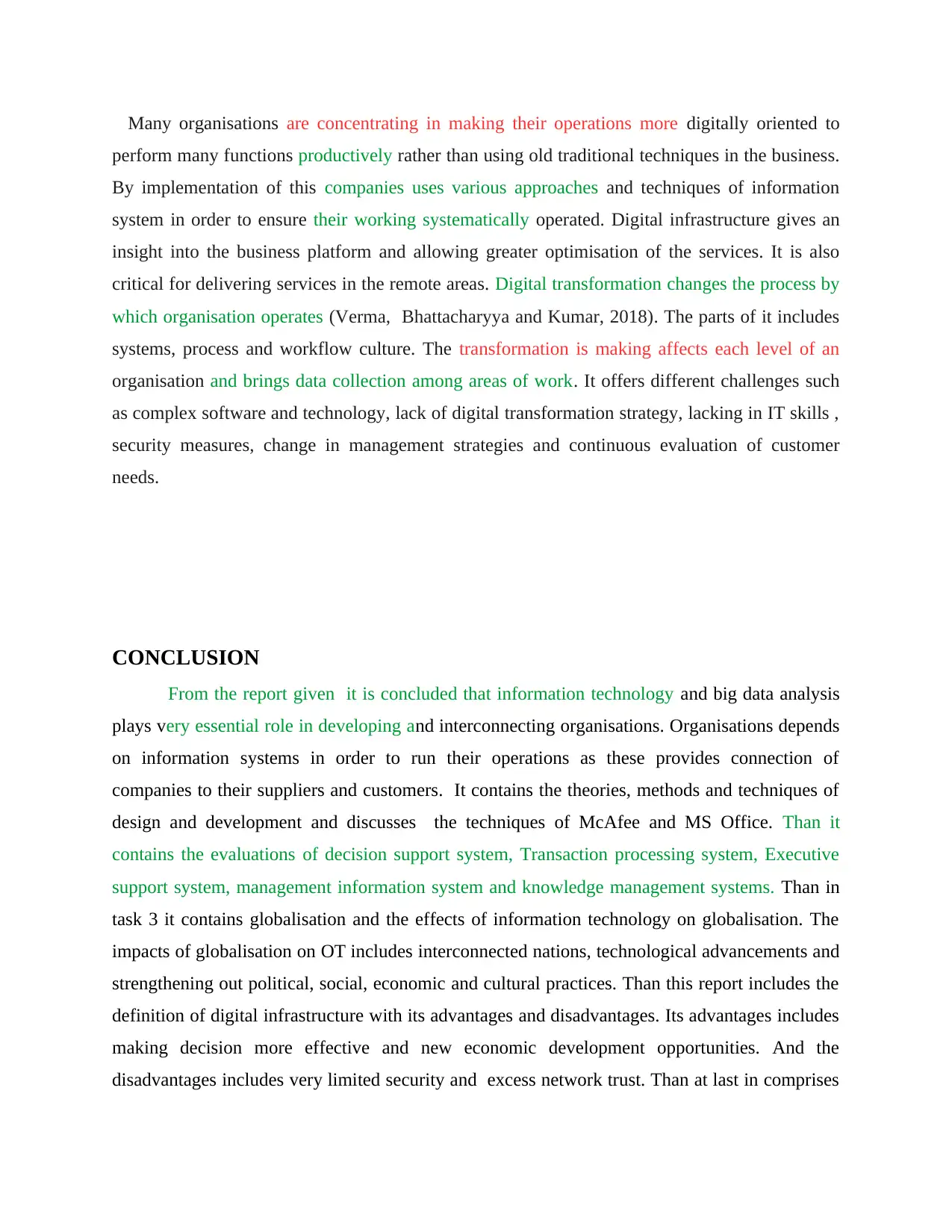
Many organisations are concentrating in making their operations more digitally oriented to
perform many functions productively rather than using old traditional techniques in the business.
By implementation of this companies uses various approaches and techniques of information
system in order to ensure their working systematically operated. Digital infrastructure gives an
insight into the business platform and allowing greater optimisation of the services. It is also
critical for delivering services in the remote areas. Digital transformation changes the process by
which organisation operates (Verma, Bhattacharyya and Kumar, 2018). The parts of it includes
systems, process and workflow culture. The transformation is making affects each level of an
organisation and brings data collection among areas of work. It offers different challenges such
as complex software and technology, lack of digital transformation strategy, lacking in IT skills ,
security measures, change in management strategies and continuous evaluation of customer
needs.
CONCLUSION
From the report given it is concluded that information technology and big data analysis
plays very essential role in developing and interconnecting organisations. Organisations depends
on information systems in order to run their operations as these provides connection of
companies to their suppliers and customers. It contains the theories, methods and techniques of
design and development and discusses the techniques of McAfee and MS Office. Than it
contains the evaluations of decision support system, Transaction processing system, Executive
support system, management information system and knowledge management systems. Than in
task 3 it contains globalisation and the effects of information technology on globalisation. The
impacts of globalisation on OT includes interconnected nations, technological advancements and
strengthening out political, social, economic and cultural practices. Than this report includes the
definition of digital infrastructure with its advantages and disadvantages. Its advantages includes
making decision more effective and new economic development opportunities. And the
disadvantages includes very limited security and excess network trust. Than at last in comprises
perform many functions productively rather than using old traditional techniques in the business.
By implementation of this companies uses various approaches and techniques of information
system in order to ensure their working systematically operated. Digital infrastructure gives an
insight into the business platform and allowing greater optimisation of the services. It is also
critical for delivering services in the remote areas. Digital transformation changes the process by
which organisation operates (Verma, Bhattacharyya and Kumar, 2018). The parts of it includes
systems, process and workflow culture. The transformation is making affects each level of an
organisation and brings data collection among areas of work. It offers different challenges such
as complex software and technology, lack of digital transformation strategy, lacking in IT skills ,
security measures, change in management strategies and continuous evaluation of customer
needs.
CONCLUSION
From the report given it is concluded that information technology and big data analysis
plays very essential role in developing and interconnecting organisations. Organisations depends
on information systems in order to run their operations as these provides connection of
companies to their suppliers and customers. It contains the theories, methods and techniques of
design and development and discusses the techniques of McAfee and MS Office. Than it
contains the evaluations of decision support system, Transaction processing system, Executive
support system, management information system and knowledge management systems. Than in
task 3 it contains globalisation and the effects of information technology on globalisation. The
impacts of globalisation on OT includes interconnected nations, technological advancements and
strengthening out political, social, economic and cultural practices. Than this report includes the
definition of digital infrastructure with its advantages and disadvantages. Its advantages includes
making decision more effective and new economic development opportunities. And the
disadvantages includes very limited security and excess network trust. Than at last in comprises

the risks that attached with information system outsourcing and why information technology is
so critical in digital changes. The risk involved in it are risk of data protection, virus and
malware and lack of professionalism.
so critical in digital changes. The risk involved in it are risk of data protection, virus and
malware and lack of professionalism.
Secure Best Marks with AI Grader
Need help grading? Try our AI Grader for instant feedback on your assignments.
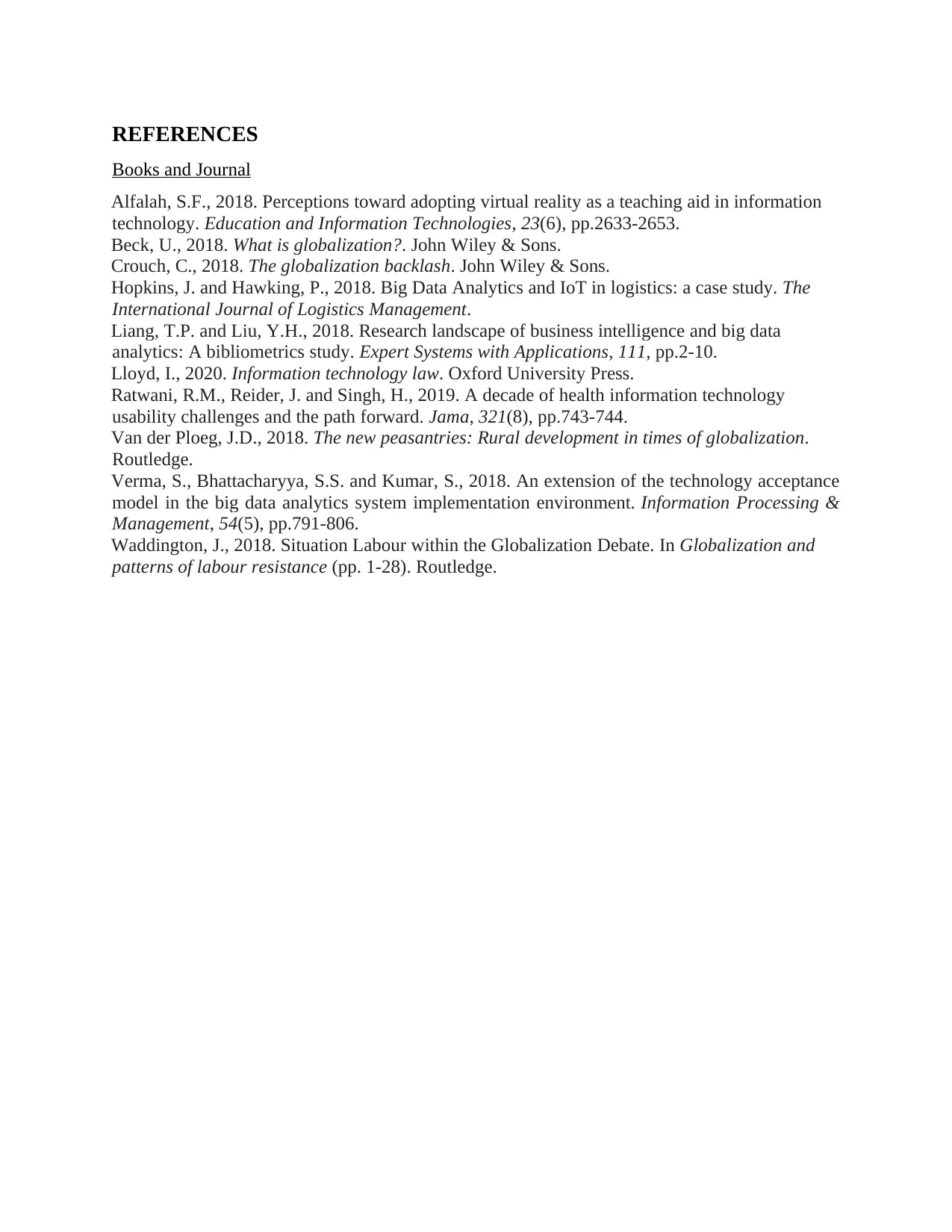
REFERENCES
Books and Journal
Alfalah, S.F., 2018. Perceptions toward adopting virtual reality as a teaching aid in information
technology. Education and Information Technologies, 23(6), pp.2633-2653.
Beck, U., 2018. What is globalization?. John Wiley & Sons.
Crouch, C., 2018. The globalization backlash. John Wiley & Sons.
Hopkins, J. and Hawking, P., 2018. Big Data Analytics and IoT in logistics: a case study. The
International Journal of Logistics Management.
Liang, T.P. and Liu, Y.H., 2018. Research landscape of business intelligence and big data
analytics: A bibliometrics study. Expert Systems with Applications, 111, pp.2-10.
Lloyd, I., 2020. Information technology law. Oxford University Press.
Ratwani, R.M., Reider, J. and Singh, H., 2019. A decade of health information technology
usability challenges and the path forward. Jama, 321(8), pp.743-744.
Van der Ploeg, J.D., 2018. The new peasantries: Rural development in times of globalization.
Routledge.
Verma, S., Bhattacharyya, S.S. and Kumar, S., 2018. An extension of the technology acceptance
model in the big data analytics system implementation environment. Information Processing &
Management, 54(5), pp.791-806.
Waddington, J., 2018. Situation Labour within the Globalization Debate. In Globalization and
patterns of labour resistance (pp. 1-28). Routledge.
Books and Journal
Alfalah, S.F., 2018. Perceptions toward adopting virtual reality as a teaching aid in information
technology. Education and Information Technologies, 23(6), pp.2633-2653.
Beck, U., 2018. What is globalization?. John Wiley & Sons.
Crouch, C., 2018. The globalization backlash. John Wiley & Sons.
Hopkins, J. and Hawking, P., 2018. Big Data Analytics and IoT in logistics: a case study. The
International Journal of Logistics Management.
Liang, T.P. and Liu, Y.H., 2018. Research landscape of business intelligence and big data
analytics: A bibliometrics study. Expert Systems with Applications, 111, pp.2-10.
Lloyd, I., 2020. Information technology law. Oxford University Press.
Ratwani, R.M., Reider, J. and Singh, H., 2019. A decade of health information technology
usability challenges and the path forward. Jama, 321(8), pp.743-744.
Van der Ploeg, J.D., 2018. The new peasantries: Rural development in times of globalization.
Routledge.
Verma, S., Bhattacharyya, S.S. and Kumar, S., 2018. An extension of the technology acceptance
model in the big data analytics system implementation environment. Information Processing &
Management, 54(5), pp.791-806.
Waddington, J., 2018. Situation Labour within the Globalization Debate. In Globalization and
patterns of labour resistance (pp. 1-28). Routledge.
1 out of 11
Related Documents
Your All-in-One AI-Powered Toolkit for Academic Success.
+13062052269
info@desklib.com
Available 24*7 on WhatsApp / Email
![[object Object]](/_next/static/media/star-bottom.7253800d.svg)
Unlock your academic potential
© 2024 | Zucol Services PVT LTD | All rights reserved.




